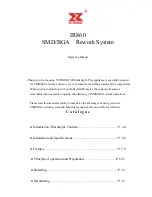
ENGLISH
WS 98
Melchioni S.p.A.
Temperature Control Soldering Station
Working temperature
Soldering at the correct temperature is very important to ensure perfect solder connection.
If the temperature is too low the solder will not flow correctly and will cause cold solder
joints. If the temperature is too high the flux will be burned and not allow the solder to flow.
High temperature can also cause damage to PC Board and other sensitive components.
When tip working temperature is set within the correct parameters suited to the particular
solder being used a good joint is assured.
The most common solder alloys used in the electronics industry is 60% tin, 40% lead
(60/40).
A common tip working temperature of 60/40 solder is detailed below (this may vary from
manufacturer to manufacturer)
Melting point
419°F (215°C)
Normal operation
518°F-572°F (215°C-300°C)
Production line operation
608°F-716°F (320°C-380°C)
Desoldering operation for
small joint
599°F (315°C)
Desoldering operation for
larger joint
752°F (400°C)
Care of the tip
The tip supplied is iron plated copper. If used properly, it will last a long time.
1. Always keep tips tinned before switching off or storing for any period of time; wipe only
before use.
2. Do not keep the iron set at high temperature for a long period of time as this will break
down the surface of the tip.
3. Never clean the tip with coarse abrasive materials or files.
4. If an oxide film does form it can be cleaned by lightly rubbing with a 600-800 grit emery
cloth, isopropyl alcohol or equivalent, and then immediately reheat and re-tin the tip to
prevent oxidation of the wettable surface.
5. Remove the tip and clean every twenty hours of use, or at least once a week, and
remove any loose build up in the barrel.
6. Do not use fluxes containing chloride or acid. Use only rosin or activated tesin fluxes.
7. Do not use any compound or anti-seize materials on the wettable surface.
NOTA: Replacment TIPS Cod. 495236101 ( 10 pcs. )
Maintenance
This tool must be placed on its stand when not in use.
If the supply cord is damaged, it must be replaced by the manufacturer of its service agent
or similarly qualified person in order to avoid a hazard.

























